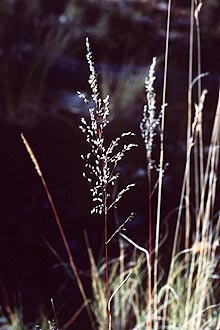Pine Dropseed

Common Name(s):
Pine Dropseed
Hairy Dropseed
Scientific Name:
Blepharoneuron tricholepis (Torr.) Nash
Scientific Name Synonyms:
None known
Symbol:
BLTR
Description:
Life Span: Perennial
Origin: Native
Season: Warm
Growth Characteristics: A slender, erect, densely tufted bunchgrass growing 10 to 13 inches tall, with basal leaves and fibrous roots. It reproduces from seeds and tillers. It starts growth in late June or early July, completes growth in September, and generally comprises only a small portion of the vegetation.
Seedhead: Panicle type inflorescence 2 to 9 inches long, which can be open or contracted. Spikelets are small, containing one floret with a distinctive greenish-gray or bluish-gray color, and with silky hairs on the keel and marginal nerves.
Leaves: Blades are abundant, but mostly small and basal, therefore providing little forage. Ligules are fringed with hairs on the margins.
Ecological Adaptions:
Pine Dropseed is native to Southern Utah and is usually found in open parks and meadows in the subalpine zone and in th open timber of the ponderosa pine and pinyon-juniper types.
Soils: Adapted to a broad range of soils, but is most abundant in rocky, moderately dry soils.
Associated Species: Mountain muhly, Junegrass, bluegrasses, ponderosa pine.
Uses and Management:
The palatability and quality of young Pine dropseed plants is very good for all classes of livestock. The quality rapidly declines with maturity. The stems are neglected or only slightly grazed after maturing. It is generally one of the highest quality grasses in timbered areas.
A healthy pine dropseed community in areas where it is native to is an indicator of a rangeland in good condition.

